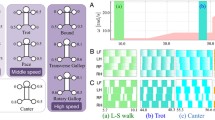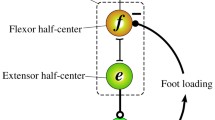Abstract.
We continue the analysis of the network of symmetrically coupled cells modeling central pattern generators (CPG) for quadruped locomotion proposed by Golubitsky, Stewart, Buono and Collins by studying secondary gaits. Secondary gaits are modeled by output signals from the CPG where each cell emits one of two different output signals along with exact phase shifts. Examples of secondary gaits are transverse gallop, rotary gallop, and canter. We classify secondary gaits that bifurcate when the Poincaré map of a primary gait has a real eigenvalue crossing the unit circle. In particular, we show that periodic solutions modeling transverse gallop and rotary gallop bifurcate from primary gaits. Moreover, we find gaits from period-doubling bifurcations and analyze plausible footfall patterns. Numerical simulations are performed using the Morris-Lecar equations as cell dynamics.
Similar content being viewed by others
Author information
Authors and Affiliations
Additional information
Received: 16 February 2000 / Revised version: 5 October 2000¶Published online: 16 March 2001
Rights and permissions
About this article
Cite this article
Buono, PL. Models of central pattern generators for quadruped locomotion II. Secondary gaits. J Math Biol 42, 327–346 (2001). https://doi.org/10.1007/s002850000073
Issue Date:
DOI: https://doi.org/10.1007/s002850000073




